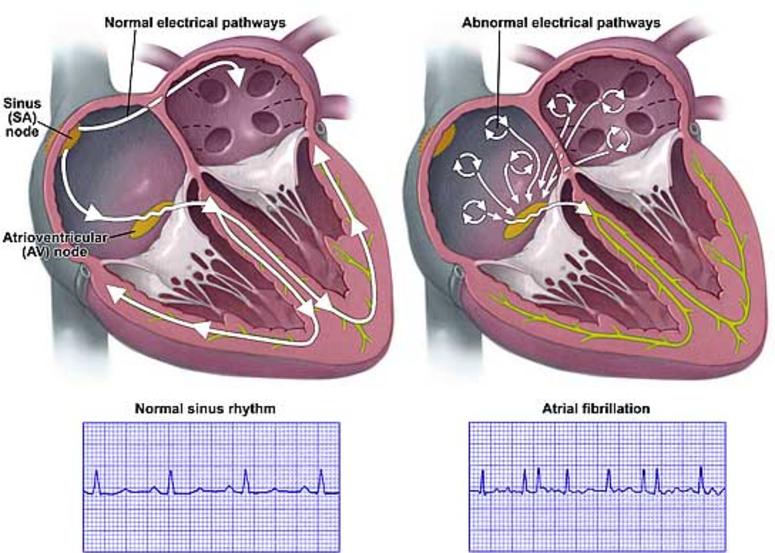
The Normal Heart Rhythm
The heart pumps blood to the rest of the body. During each heart beat, the two upper chambers of the heart (atria) contract, followed by the two lower chambers (ventricles). These actions, when timed perfectly, allow for an efficient pump. The timing of the heart's contractions is directed by the heart's electrical system.
The electrical impulse begins in the sinoatrial (SA node), located in the right atrium. Normally, the SA node adjusts the rate of impulses, depending on the person's activity. 8 slot picture frame. For example, the SA node increases the rate of impulses during exercise and decreases the rate of impulses during sleep.
- Atrial fibrillation (AFib) is a type of irregular heartbeat, which can include rapid heartbeat or skipped beats. You can usually recognize an AFib episode because you'll feel a fluttering in your chest, possibly with fatigue, dizziness, or shortness of breath.
- Atrial fibrillation (AFib) occurs when the normal rhythmic pumping of the upper chambers of the heart, called the atria, breaks down. Instead of a normal heart rate, the atria pulse, or fibrillate.
Treatment Options of Atrial Fibrillation (AFib or AF) The severity, any other underlying medical issues you might have, and the length of the AF condition will determine the best treatment options for you.
Slots 30 machine app download. When the SA node fires an impulse, electrical activity spreads through the right and left atria, causing them to contract and force blood into the ventricles.
The impulse travels to the atrioventricular (AV) node, located in the septum (near the middle of the heart). The AV node is the only electrical bridge that allows the impulses to travel from the atria to the ventricles. The impulse travels through the walls of the ventricles, causing them to contract. They squeeze and pump blood out of the heart. The right ventricle pumps blood to the lungs, and the left ventricle pumps blood to the body.
When the SA node is directing the electrical activity of the heart, the rhythm is called 'normal sinus rhythm.' The normal heart beats in this type of regular rhythm, about 60 to 100 times per minute at rest.
ECG recording of normal heart rhythm
What is atrial fibrillation?
How To Stop Atrial Fibrillation

Atrial fibrillation (AF or AFib) is the most common irregular heart rhythm that starts in the atria. Instead of the SA node (sinus node) directing the electrical rhythm, many different impulses rapidly fire at once, causing a very fast, chaotic rhythm in the atria. Because the electrical impulses are so fast and chaotic, the atria cannot contract and/or squeeze blood effectively into the ventricle.
An ECG recording of atrial fibrillation
Instead of the impulse traveling in an orderly fashion through the heart, many impulses begin at the same time and spread through the atria, competing for a chance to travel through the AV node. The AV node limits the number of impulses that travel to the ventricles, but many impulses get through in a fast and disorganized manner. The ventricles contract irregularly, leading to a rapid and irregular heartbeat. The rate of impulses in the atria can range from 300 to 600 beats per minute.
There are two types of atrial fibrillation. Paroxysmal is intermittent, meaning it comes and goes and continuous is persistent.
What are the dangers of atrial fibrillation?
Some people live for years with atrial fibrillation without problems. However, atrial fibrillation can lead to future problems:
- Because the atria are beating rapidly and irregularly, blood does not flow through them as quickly. This makes the blood more likely to clot. If a clot is pumped out of the heart, it can travel to the brain, resulting in a stroke. People with atrial fibrillation are 5 to 7 times more likely to have a stroke than the general population. Clots can also travel to other parts of the body (kidneys, heart, intestines), and cause other damage.
- Atrial fibrillation can decrease the heart's pumping ability. The irregularity can make the heart work less efficiently. In addition, atrial fibrillation that occurs over a long period of time can significantly weaken the heart and lead to heart failure.
- Atrial fibrillation is associated with an increased risk of stroke, heart failure and even death.
What causes atrial fibrillation?
There is no one 'cause' of atrial fibrillation, although it is associated with many conditions, including:
Most common causes
- After heart surgery
- Chronic lung disease
Less common causes

- Hyperthyroidism
- Viral infection
Occasional Atrial Fibrillation Treatment

In at least 10 percent of the cases, no underlying heart disease is found. In these cases, AF may be related to alcohol or excessive caffeine use, stress, certain drugs, electrolyte or metabolic imbalances, severe infections, or genetic factors. In some cases, no cause can be found.
Occasional Atrial Fibrillation Cause
The risk of AF increases with age, particularly after age 60.

The Normal Heart Rhythm
The heart pumps blood to the rest of the body. During each heart beat, the two upper chambers of the heart (atria) contract, followed by the two lower chambers (ventricles). These actions, when timed perfectly, allow for an efficient pump. The timing of the heart's contractions is directed by the heart's electrical system.
The electrical impulse begins in the sinoatrial (SA node), located in the right atrium. Normally, the SA node adjusts the rate of impulses, depending on the person's activity. 8 slot picture frame. For example, the SA node increases the rate of impulses during exercise and decreases the rate of impulses during sleep.
- Atrial fibrillation (AFib) is a type of irregular heartbeat, which can include rapid heartbeat or skipped beats. You can usually recognize an AFib episode because you'll feel a fluttering in your chest, possibly with fatigue, dizziness, or shortness of breath.
- Atrial fibrillation (AFib) occurs when the normal rhythmic pumping of the upper chambers of the heart, called the atria, breaks down. Instead of a normal heart rate, the atria pulse, or fibrillate.
Treatment Options of Atrial Fibrillation (AFib or AF) The severity, any other underlying medical issues you might have, and the length of the AF condition will determine the best treatment options for you.
Slots 30 machine app download. When the SA node fires an impulse, electrical activity spreads through the right and left atria, causing them to contract and force blood into the ventricles.
The impulse travels to the atrioventricular (AV) node, located in the septum (near the middle of the heart). The AV node is the only electrical bridge that allows the impulses to travel from the atria to the ventricles. The impulse travels through the walls of the ventricles, causing them to contract. They squeeze and pump blood out of the heart. The right ventricle pumps blood to the lungs, and the left ventricle pumps blood to the body.
When the SA node is directing the electrical activity of the heart, the rhythm is called 'normal sinus rhythm.' The normal heart beats in this type of regular rhythm, about 60 to 100 times per minute at rest.
ECG recording of normal heart rhythm
What is atrial fibrillation?
How To Stop Atrial Fibrillation
Atrial fibrillation (AF or AFib) is the most common irregular heart rhythm that starts in the atria. Instead of the SA node (sinus node) directing the electrical rhythm, many different impulses rapidly fire at once, causing a very fast, chaotic rhythm in the atria. Because the electrical impulses are so fast and chaotic, the atria cannot contract and/or squeeze blood effectively into the ventricle.
An ECG recording of atrial fibrillation
Instead of the impulse traveling in an orderly fashion through the heart, many impulses begin at the same time and spread through the atria, competing for a chance to travel through the AV node. The AV node limits the number of impulses that travel to the ventricles, but many impulses get through in a fast and disorganized manner. The ventricles contract irregularly, leading to a rapid and irregular heartbeat. The rate of impulses in the atria can range from 300 to 600 beats per minute.
There are two types of atrial fibrillation. Paroxysmal is intermittent, meaning it comes and goes and continuous is persistent.
What are the dangers of atrial fibrillation?
Some people live for years with atrial fibrillation without problems. However, atrial fibrillation can lead to future problems:
- Because the atria are beating rapidly and irregularly, blood does not flow through them as quickly. This makes the blood more likely to clot. If a clot is pumped out of the heart, it can travel to the brain, resulting in a stroke. People with atrial fibrillation are 5 to 7 times more likely to have a stroke than the general population. Clots can also travel to other parts of the body (kidneys, heart, intestines), and cause other damage.
- Atrial fibrillation can decrease the heart's pumping ability. The irregularity can make the heart work less efficiently. In addition, atrial fibrillation that occurs over a long period of time can significantly weaken the heart and lead to heart failure.
- Atrial fibrillation is associated with an increased risk of stroke, heart failure and even death.
What causes atrial fibrillation?
There is no one 'cause' of atrial fibrillation, although it is associated with many conditions, including:
Most common causes
- After heart surgery
- Chronic lung disease
Less common causes
- Hyperthyroidism
- Viral infection
Occasional Atrial Fibrillation Treatment
In at least 10 percent of the cases, no underlying heart disease is found. In these cases, AF may be related to alcohol or excessive caffeine use, stress, certain drugs, electrolyte or metabolic imbalances, severe infections, or genetic factors. In some cases, no cause can be found.
Occasional Atrial Fibrillation Cause
The risk of AF increases with age, particularly after age 60.
Atrial Fibrillation Symptoms And Treatment
What are the symptoms of atrial fibrillation?
You may have atrial fibrillation without having any symptoms. If you have symptoms, they may include:
- Heart palpitations - Sudden pounding, fluttering or racing sensation in the chest
- Lack of energy or feeling over-tired
- Dizziness - Feeling light-headed or faint
- Chest discomfort - Pain, pressure or discomfort in the chest
- Shortness of breath - Having difficulty breathing during normal activities and even at rest
